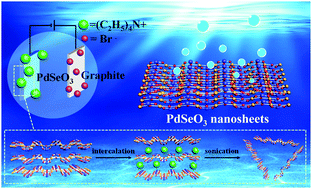Atomically thin PdSeO3 nanosheets: a promising 2D photocatalyst produced by quaternary ammonium intercalation and exfoliation†
Abstract
In 2018, the two-dimensional (2D) PdSeO3 monolayer was predicted to be a highly promising photocatalyst for direct overall water splitting in the light of density functional theory (DFT) computations. Herein, we present the first report on the synthesis of 2D PdSeO3 nanosheets by using the quaternary ammonium intercalation-assisted electrochemical exfoliation method. The resulting atomically thin PdSeO3 nanosheets possess a moderate band gap with suitable band edge alignments for water splitting, and display excellent activity and stability in photocatalytic H2 evolution.



 Please wait while we load your content...
Please wait while we load your content...